缺失值处理
处理缺失值的四种方法
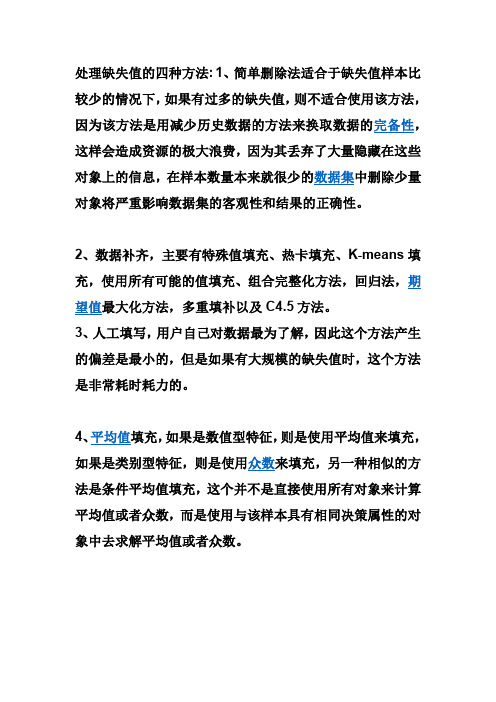
处理缺失值的四种方法:1、简单删除法适合于缺失值样本比较少的情况下,如果有过多的缺失值,则不适合使用该方法,
这样会造成资源的极大浪费,因为其丢弃了大量隐藏在这些
对象将严重影响数据集的客观性和结果的正确性。
2、数据补齐,主要有特殊值填充、热卡填充、K-means填
3、人工填写,用户自己对数据最为了解,因此这个方法产生的偏差是最小的,但是如果有大规模的缺失值时,这个方法是非常耗时耗力的。
法是条件平均值填充,这个并不是直接使用所有对象来计算平均值或者众数,而是使用与该样本具有相同决策属性的对象中去求解平均值或者众数。
处理缺失值 方法
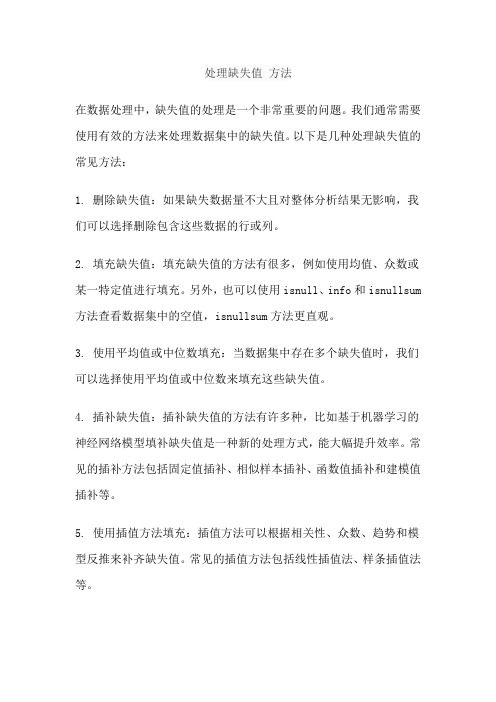
处理缺失值方法
在数据处理中,缺失值的处理是一个非常重要的问题。
我们通常需要使用有效的方法来处理数据集中的缺失值。
以下是几种处理缺失值的常见方法:
1. 删除缺失值:如果缺失数据量不大且对整体分析结果无影响,我们可以选择删除包含这些数据的行或列。
2. 填充缺失值:填充缺失值的方法有很多,例如使用均值、众数或某一特定值进行填充。
另外,也可以使用isnull、info和isnullsum 方法查看数据集中的空值,isnullsum方法更直观。
3. 使用平均值或中位数填充:当数据集中存在多个缺失值时,我们可以选择使用平均值或中位数来填充这些缺失值。
4. 插补缺失值:插补缺失值的方法有许多种,比如基于机器学习的神经网络模型填补缺失值是一种新的处理方式,能大幅提升效率。
常见的插补方法包括固定值插补、相似样本插补、函数值插补和建模值插补等。
5. 使用插值方法填充:插值方法可以根据相关性、众数、趋势和模型反推来补齐缺失值。
常见的插值方法包括线性插值法、样条插值法等。
总之,处理缺失值的方法多种多样,具体应根据数据的具体情况选择合适的方法。
补缺失值的方法
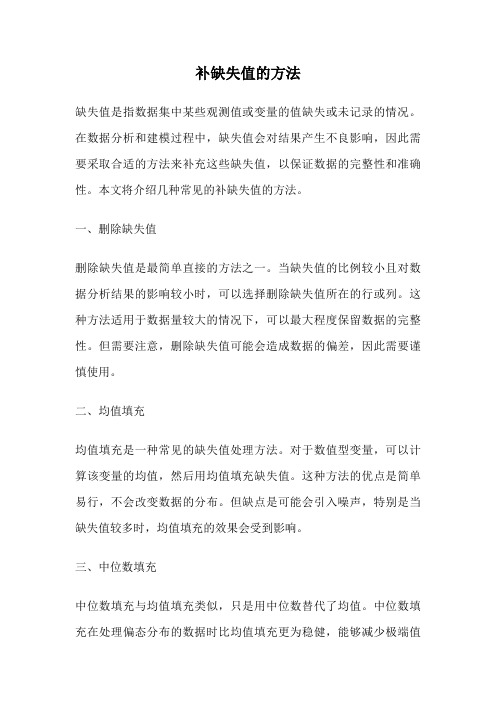
补缺失值的方法缺失值是指数据集中某些观测值或变量的值缺失或未记录的情况。
在数据分析和建模过程中,缺失值会对结果产生不良影响,因此需要采取合适的方法来补充这些缺失值,以保证数据的完整性和准确性。
本文将介绍几种常见的补缺失值的方法。
一、删除缺失值删除缺失值是最简单直接的方法之一。
当缺失值的比例较小且对数据分析结果的影响较小时,可以选择删除缺失值所在的行或列。
这种方法适用于数据量较大的情况下,可以最大程度保留数据的完整性。
但需要注意,删除缺失值可能会造成数据的偏差,因此需要谨慎使用。
二、均值填充均值填充是一种常见的缺失值处理方法。
对于数值型变量,可以计算该变量的均值,然后用均值填充缺失值。
这种方法的优点是简单易行,不会改变数据的分布。
但缺点是可能会引入噪声,特别是当缺失值较多时,均值填充的效果会受到影响。
三、中位数填充中位数填充与均值填充类似,只是用中位数替代了均值。
中位数填充在处理偏态分布的数据时比均值填充更为稳健,能够减少极端值对填充结果的影响。
然而,中位数填充也存在一定的局限性,特别是当数据中存在较多的离群值时,中位数填充可能会引入偏差。
四、众数填充众数填充是一种适用于分类变量的方法。
对于分类变量,可以计算该变量的众数,并用众数填充缺失值。
众数填充的优点是简单易行,可以保留变量的分布特征。
但需要注意,众数填充可能会导致数据的不均衡,特别是当某个类别的频数较高时,填充的结果可能会偏向于该类别。
五、回归填充回归填充是一种基于回归模型的方法。
对于数值型变量,可以利用其他变量的信息,建立回归模型,然后预测缺失值。
回归填充的优点是可以利用其他变量的信息,提高填充的准确性。
但需要注意,回归填充的结果受到回归模型的选择和变量的相关性等因素的影响。
六、插值填充插值填充是一种基于插值方法的方法。
常用的插值方法包括线性插值、多项式插值、样条插值等。
插值填充的优点是可以根据数据的特点进行灵活的插值,填充结果较为准确。
数据缺失值填补方法

数据缺失值填补方法在数据分析中,我们经常会遇到含有缺失值的数据。
缺失值的处理是一个重要的问题,因为它可能影响数据分析的准确性和可靠性。
以下是几种常用的数据缺失值填补方法:1. 删除缺失值删除缺失值是一种简单的方法,也是最直接的处理方式。
这种方法的基本思想是,如果某个数据点存在缺失值,就将其删除。
然而,这种方法可能会造成数据损失,特别是在数据集较小或者缺失值比例较大时。
2. 填充缺失值填充缺失值是一种常见的方法,其基本思想是,用某个固定的值来填充缺失的数据点。
例如,可以将缺失值填充为0,或者使用数据集中的均值、中位数或众数来填充。
这种方法简单易用,但可能会忽略缺失值背后的真实信息。
3. 插补缺失值插补是一种更复杂的填充方法,其基本思想是,用其他数据来替代缺失的数据点。
例如,可以使用最近邻插补、均值插补或回归插补等方法。
这种方法可以更好地利用数据集中的信息,但仍然可能存在一定的偏差。
4. 回归填补缺失值回归填补是一种基于统计学的方法,其基本思想是,通过已有的数据和变量之间的关系,来预测缺失的数据点。
例如,可以使用线性回归或多重回归等方法来预测缺失值。
这种方法可以更好地处理复杂的数据关系,但需要有一定的统计学知识。
5. 机器学习填补缺失值机器学习填补是一种基于人工智能的方法,其基本思想是,通过机器学习算法来自动填补缺失的数据点。
例如,可以使用聚类、决策树或神经网络等方法来预测缺失值。
这种方法可以更好地处理大规模和复杂的数据集,但需要有一定的计算机科学知识。
在实际应用中,选择哪种方法取决于数据的性质、目标和实际情况。
一般来说,删除和填充方法适用于简单和较小规模的数据集,而插补、回归和机器学习填补方法适用于复杂和较大规模的数据集。
无论采用哪种方法,都需要注意方法的局限性和可能存在的偏差。
缺失值及其处理方法
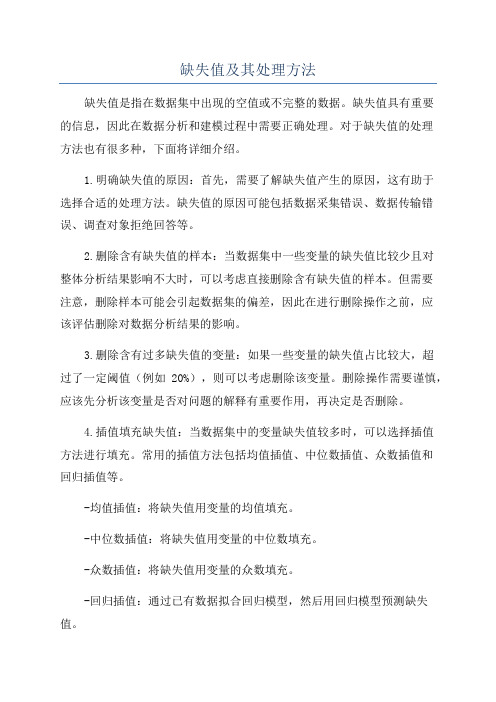
缺失值及其处理方法缺失值是指在数据集中出现的空值或不完整的数据。
缺失值具有重要的信息,因此在数据分析和建模过程中需要正确处理。
对于缺失值的处理方法也有很多种,下面将详细介绍。
1.明确缺失值的原因:首先,需要了解缺失值产生的原因,这有助于选择合适的处理方法。
缺失值的原因可能包括数据采集错误、数据传输错误、调查对象拒绝回答等。
2.删除含有缺失值的样本:当数据集中一些变量的缺失值比较少且对整体分析结果影响不大时,可以考虑直接删除含有缺失值的样本。
但需要注意,删除样本可能会引起数据集的偏差,因此在进行删除操作之前,应该评估删除对数据分析结果的影响。
3.删除含有过多缺失值的变量:如果一些变量的缺失值占比较大,超过了一定阈值(例如20%),则可以考虑删除该变量。
删除操作需要谨慎,应该先分析该变量是否对问题的解释有重要作用,再决定是否删除。
4.插值填充缺失值:当数据集中的变量缺失值较多时,可以选择插值方法进行填充。
常用的插值方法包括均值插值、中位数插值、众数插值和回归插值等。
-均值插值:将缺失值用变量的均值填充。
-中位数插值:将缺失值用变量的中位数填充。
-众数插值:将缺失值用变量的众数填充。
-回归插值:通过已有数据拟合回归模型,然后用回归模型预测缺失值。
5.分类变量的处理方法:对于分类变量,可以将缺失值单独作为一类,或者根据其他变量的取值特征进行填充。
-将缺失值单独作为一类:如果缺失值对问题的解释具有特殊意义,可以将缺失值单独作为一类。
-根据其他变量的取值特征进行填充:可以根据其他变量的取值特征进行填充,例如使用频率最高的取值填充缺失值。
6.时间序列数据的处理方法:对于时间序列数据,可以根据已有数据的趋势和周期性进行填充。
-线性插值:通过已有数据拟合线性回归模型,然后使用模型预测缺失值。
-滑动窗口方法:根据一定的窗口大小,对于缺失位置的每一侧,根据已有数据的均值或中位数进行填充。
-季节分解方法:将时间序列数据进行季节分解,然后根据季节分解的结果进行填充。
数据分析中常见的缺失数据处理方法

数据分析中常见的缺失数据处理方法在数据分析的过程中,经常会遇到缺失数据的情况。
缺失数据可能是由于数据收集过程中的错误、数据损坏、用户不愿意提供某些信息等原因引起的。
处理缺失数据是数据分析的重要一环,合理地处理缺失数据可以提高数据分析的准确性和可靠性。
本文将介绍几种常见的缺失数据处理方法。
一、删除法删除法是最简单、最直接的缺失数据处理方法之一。
当数据中存在缺失值时,可以选择将含有缺失值的样本或变量删除。
这种方法的优点是简单、方便,可以减少对数据的干扰。
然而,删除法也有一些缺点。
首先,删除缺失数据可能会导致样本量的减少,从而影响数据分析的结果。
其次,删除缺失数据可能会引入样本选择偏差,使得分析结果不具有代表性。
因此,在使用删除法处理缺失数据时,需要根据具体情况权衡利弊。
二、插补法插补法是一种常见的缺失数据处理方法,它通过根据已有数据的特征来估计缺失数据的值。
插补法可以分为单变量插补和多变量插补两种。
单变量插补是指根据其他变量的信息来估计缺失变量的值。
常见的单变量插补方法包括均值插补、中位数插补和众数插补。
均值插补是指用变量的均值来代替缺失值,适用于连续变量;中位数插补是指用变量的中位数来代替缺失值,适用于偏态分布的连续变量;众数插补是指用变量的众数来代替缺失值,适用于离散变量。
多变量插补是指根据其他变量之间的关系来估计缺失变量的值。
常见的多变量插补方法包括回归插补和插补法。
回归插补是指根据其他变量与缺失变量之间的线性关系来估计缺失变量的值;插补法是指根据其他变量的均值或众数来估计缺失变量的值。
插补法的优点是能够保留样本的完整性,减少样本量的损失。
然而,插补法也有一些缺点。
首先,插补法的准确性依赖于已有数据的质量和缺失数据的性质。
如果已有数据中存在较大的误差或缺失数据的性质复杂,插补法可能会引入较大的估计误差。
其次,插补法可能会引入额外的变异性,从而影响数据分析的结果。
因此,在使用插补法处理缺失数据时,需要谨慎选择合适的插补方法,并进行敏感性分析。
临床数据缺失值处理

临床数据缺失值处理临床数据缺失值处理是数据分析和统计领域中一个非常重要的问题。
在临床研究中,由于各种原因,会出现数据缺失现象,即某些观测变量的值在数据集中未能完整记录下来。
缺失值的处理对于数据分析的精确性和可靠性具有很大的影响,因此需要采取适当的方法来解决。
首先,需要了解和分析缺失数据的原因。
常见的缺失数据的原因包括患者拒绝提供某些个人信息、技术问题导致的数据丢失、观测过程中发生的错误等。
根据缺失数据的原因,可以采取不同的处理方法。
1.删除缺失值:最简单的方法是直接删除含有缺失值的观测样本或变量。
这种方法的优点是简单快捷,但缺点是会导致样本量的减少和数据的丢失,可能会引入偏差。
2.插补缺失值:插补是一种常用的缺失数据处理方法。
插补的目的是根据已有的数据来估计缺失值,并使用估计值代替缺失值。
插补方法可以分为单变量插补和多变量插补。
-单变量插补:单变量插补方法基于已观测的其他变量来估计缺失值。
常用的单变量插补方法包括均值插补、中位数插补、分位数插补等。
这种方法的优点是简单易实施,但假设其他变量与缺失变量之间存在线性关系,并忽略了变量之间的相互作用。
-多变量插补:多变量插补方法考虑了多个变量之间的关系,利用已有变量之间的相关性来估计缺失值。
常见的多变量插补方法包括回归插补、EM算法等。
这种方法的优点是更准确地估计缺失值,但计算复杂度较高。
3.模型建立:对于临床数据的缺失值,也可以根据研究目的建立模型来预测缺失值。
例如,可以使用机器学习算法建立预测模型,并使用模型来预测缺失值。
这种方法的优点是可以综合考虑多个变量之间的关系,并能够提供患者个体化的预测结果。
除了上述方法外,还可以采用多重插补、专家咨询等方法来处理临床数据的缺失值。
多重插补将缺失值插补多次生成多个完整数据集,然后进行分析汇总;专家咨询可以通过专业知识来估计缺失值。
这些方法的选择应根据具体情况和研究目的来确定。
在进行缺失数据处理之前,应该对数据进行探索性分析,了解缺失数据的分布特点、缺失机制等情况,以选择合适的处理方法。
数据缺失处理方法

数据缺失处理方法数据缺失是指在数据采集或者存储过程中,某些数据项没有被记录或者保存下来的情况。
数据缺失可能是由于技术故障、人为错误、数据传输错误或者其他原因导致的。
在处理数据缺失时,我们需要采取一些方法来处理缺失的数据,以确保数据的完整性和准确性。
以下是一些常用的数据缺失处理方法:1. 删除缺失数据行如果缺失数据的比例非常小,我们可以选择直接删除包含缺失数据的行。
这种方法适合于数据缺失的比例较低且缺失数据对整体数据分析结果影响不大的情况。
2. 删除缺失数据列如果某一列的数据缺失比例过高,可以选择删除该列。
这种方法适合于该列数据对整体分析结果的影响较小或者可以通过其他列数据进行判断的情况。
3. 插值法填补缺失值插值法是一种常用的数据缺失处理方法,它通过已知数据判断缺失数据的值。
常用的插值方法包括线性插值、多项式插值、样条插值等。
选择合适的插值方法需要考虑数据的特点和缺失数据的分布情况。
4. 均值、中位数或者众数填补缺失值对于数值型数据,我们可以使用均值、中位数或者众数来填补缺失值。
均值填补适合于数据分布近似正态的情况,中位数填补适合于数据存在较多异常值的情况,众数填补适合于数据呈现明显偏态分布的情况。
5. 使用机器学习算法预测缺失值对于大规模的数据集或者缺失数据较多的情况,可以使用机器学习算法来预测缺失值。
常用的算法包括决策树、随机森林、支持向量机等。
通过训练模型,我们可以利用已有数据来预测缺失数据的值。
6. 多重插补法多重插补法是一种基于模型的缺失数据处理方法,它通过建立模型来估计缺失数据的值。
多重插补法的核心思想是通过多次填补缺失值并生成多个完整数据集,然后基于这些完整数据集进行分析。
常用的多重插补方法包括多重线性回归插补、多重插补的回归树等。
7. 使用专业软件处理缺失值当数据缺失较为复杂或者处理方法较为繁琐时,可以使用专业的数据处理软件来处理缺失值。
这些软件通常提供了各种处理缺失值的方法和工具,能够更方便地进行数据缺失处理。
缺失值的处理方法

缺失值的处理方法缺失值是指在数据集中一些变量的观测值缺失或未被记录的情况。
缺失值的存在可能会对数据分析和建模造成严重的影响,因此需要选择适当的方法来处理缺失值。
在处理缺失值之前,首先需要对数据集进行缺失值的识别和理解。
常见的缺失值表示符号有:NA、NaN、NULL、-999、空白格等。
缺失值的原因可能包括数据采集的错误、数据损坏、数据没有被记录等。
在理解了缺失值的情况之后,可以选择以下方法来处理缺失值。
1.删除观测值或变量:如果缺失值的比例较小且随机分布,可以选择直接删除包含缺失值的观测值或变量。
但是,如果缺失值的比例较大或缺失值的分布与其他变量存在关联,删除观测值或变量可能会引入偏差,因此需要慎重考虑。
2.插补:插补是指通过一定的方法估计和填充缺失值。
常见的插补方法包括:均值插补、中位数插补、众数插补、回归插补、插值法等。
-均值插补:对于缺失的连续变量,可以使用该变量的均值来代替缺失值。
这种方法简单易行,但可能会引入随机误差。
-中位数插补:对于缺失的连续变量,可以使用该变量的中位数来代替缺失值。
与均值插补相比,中位数插补更稳健,对于存在离群值的变量更合适。
-众数插补:对于缺失的分类变量,可以使用该变量的众数来代替缺失值。
众数插补适用于缺失比例较低的分类变量,但可能会引入偏倚。
-回归插补:当存在与缺失变量相关的其他变量时,可以使用回归模型来预测缺失值。
这种方法能够较好地利用其他变量的信息,但可能会引入建模误差。
-插值法:插值法是指通过已有观测值的插值来估计缺失值。
常见的插值方法有线性插值、多项式插值、样条插值等。
插值方法适用于具有时间序列或空间分布特点的数据,但对于大规模数据集可能计算开销较大。
3.分类变量编码:对于缺失的分类变量,可以将缺失值作为一类进行编码。
这样可以保留缺失值的存在,并将其作为一个特征进行建模分析。
4.基于模型的方法:基于模型的方法是指根据已有数据的模式,通过建立模型来预测缺失值。
数据缺失处理方法

数据缺失处理方法数据缺失是指在数据采集、存储或者分析过程中,某些数据项或者观测值未能被完整地记录或者获取到。
数据缺失可能会导致分析结果不许确,影响决策的可靠性。
因此,正确处理数据缺失是数据分析的重要环节之一。
本文将介绍几种常见的数据缺失处理方法。
一、删除缺失数据最简单的处理方法是直接删除包含缺失数据的样本或者变量。
这种方法适合于数据缺失的比例较小且缺失的样本或者变量对整体分析结果影响较小的情况。
删除缺失数据可以保持数据集的完整性,但可能会导致样本量减少,从而降低分析的统计功效。
二、插补缺失数据插补是指通过某种方法来估计和填补缺失数据。
常见的插补方法包括均值插补、中位数插补、回归插补和多重插补等。
1. 均值插补:对于数值型变量,可以用该变量的均值来填补缺失值。
这种方法简单快捷,但可能会导致数据的分布发生变化。
2. 中位数插补:对于偏态分布的数值型变量,可以用该变量的中位数来填补缺失值。
中位数对于异常值的影响较小,能更好地保持数据的分布特征。
3. 回归插补:对于存在相关性的变量,可以利用其他变量的信息来预测缺失值。
回归插补可以通过建立回归模型来估计缺失值,并利用模型的预测值来填补缺失数据。
4. 多重插补:多重插补是一种基于模型的插补方法,通过多次摹拟生成多个完整的数据集,并对每一个数据集进行分析,最后将多个分析结果进行汇总。
多重插补能够更好地反映数据的不确定性,提高分析结果的可靠性。
三、创建缺失指示变量除了插补缺失数据外,还可以通过创建缺失指示变量来处理数据缺失。
缺失指示变量是一种二元变量,用于表示原始变量是否缺失。
通过引入缺失指示变量,可以将缺失数据作为一个独立的类别进行分析,避免对数据进行插补而引入的偏差。
四、使用专门的缺失值处理算法除了上述常见的处理方法外,还有一些专门针对缺失值处理的算法,如KNN插补、EM算法等。
这些算法能够更精确地估计缺失值,并提供更准确的分析结果。
需要注意的是,选择何种处理方法应根据数据缺失的原因、缺失的比例以及对分析结果的要求来决定。
处理缺失值的四种方法
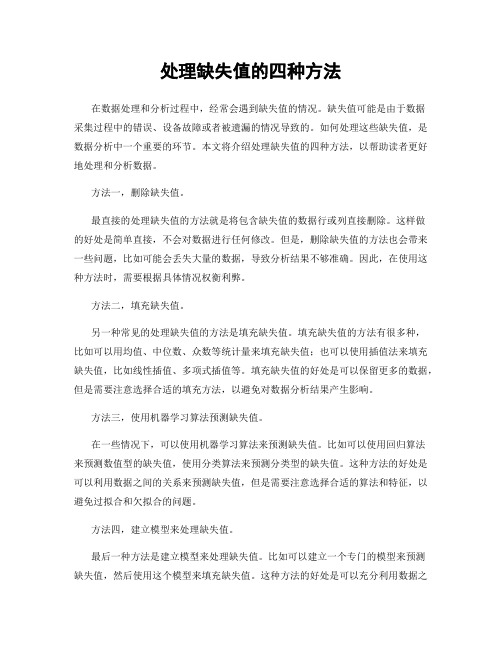
处理缺失值的四种方法在数据处理和分析过程中,经常会遇到缺失值的情况。
缺失值可能是由于数据采集过程中的错误、设备故障或者被遗漏的情况导致的。
如何处理这些缺失值,是数据分析中一个重要的环节。
本文将介绍处理缺失值的四种方法,以帮助读者更好地处理和分析数据。
方法一,删除缺失值。
最直接的处理缺失值的方法就是将包含缺失值的数据行或列直接删除。
这样做的好处是简单直接,不会对数据进行任何修改。
但是,删除缺失值的方法也会带来一些问题,比如可能会丢失大量的数据,导致分析结果不够准确。
因此,在使用这种方法时,需要根据具体情况权衡利弊。
方法二,填充缺失值。
另一种常见的处理缺失值的方法是填充缺失值。
填充缺失值的方法有很多种,比如可以用均值、中位数、众数等统计量来填充缺失值;也可以使用插值法来填充缺失值,比如线性插值、多项式插值等。
填充缺失值的好处是可以保留更多的数据,但是需要注意选择合适的填充方法,以避免对数据分析结果产生影响。
方法三,使用机器学习算法预测缺失值。
在一些情况下,可以使用机器学习算法来预测缺失值。
比如可以使用回归算法来预测数值型的缺失值,使用分类算法来预测分类型的缺失值。
这种方法的好处是可以利用数据之间的关系来预测缺失值,但是需要注意选择合适的算法和特征,以避免过拟合和欠拟合的问题。
方法四,建立模型来处理缺失值。
最后一种方法是建立模型来处理缺失值。
比如可以建立一个专门的模型来预测缺失值,然后使用这个模型来填充缺失值。
这种方法的好处是可以充分利用数据之间的关系来处理缺失值,但是需要注意选择合适的模型和特征,以避免模型复杂度过高或者过低的问题。
总结。
处理缺失值是数据分析过程中一个重要的环节。
本文介绍了处理缺失值的四种方法,包括删除缺失值、填充缺失值、使用机器学习算法预测缺失值和建立模型来处理缺失值。
在实际应用中,需要根据具体情况选择合适的方法来处理缺失值,以确保数据分析结果的准确性和可靠性。
希望本文能够对读者在处理缺失值时有所帮助。
缺失数据处理方式

缺失数据处理方式
处理缺失数据的方法主要有以下几种:
1. 删除含有缺失值的个案:主要有简单删除法和权重法。
简单删除法是对缺失值进行处理的最原始方法。
它将存在缺失值的个案删除。
如果数据缺失问题可以通过简单的删除小部分样本来达到目标,那么这个方法是最有效的。
当缺失值的类型为非完全随机缺失的时候,可以通过对完整的数据加权来减小偏差。
把数据不完全的个案标记后,将完整的数据个案赋予不同的权重,个案的权重可以通过logistic或probit回归求得。
如果解释变量中存在对权重估计起决定行因素的变量,那么这种方法可以有效减小偏差。
如果解释变量和权重并不相关,它并不能减小偏差。
对于存在多个属性缺失的情况,就需要对不同属性的缺失组合赋不同的权重,这将大大增加计算的难度,降低预测的准确性,这时权重法并不理想。
2. 可能值插补缺失值:它的思想来源是以最可能的值来插补缺失值比全部删除不完全样本所产生的信息丢失要少。
请注意,这些方法并不是万能的,具体选择哪种方法取决于数据的性质、分析的目的以及可用的资源和工具。
在处理缺失数据时,应始终考虑到可能存在的偏差和误导。
处理缺失值的四种方法
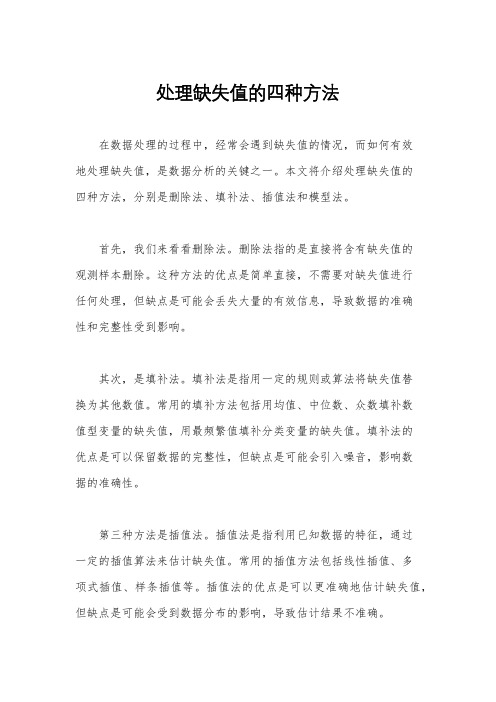
处理缺失值的四种方法在数据处理的过程中,经常会遇到缺失值的情况,而如何有效地处理缺失值,是数据分析的关键之一。
本文将介绍处理缺失值的四种方法,分别是删除法、填补法、插值法和模型法。
首先,我们来看看删除法。
删除法指的是直接将含有缺失值的观测样本删除。
这种方法的优点是简单直接,不需要对缺失值进行任何处理,但缺点是可能会丢失大量的有效信息,导致数据的准确性和完整性受到影响。
其次,是填补法。
填补法是指用一定的规则或算法将缺失值替换为其他数值。
常用的填补方法包括用均值、中位数、众数填补数值型变量的缺失值,用最频繁值填补分类变量的缺失值。
填补法的优点是可以保留数据的完整性,但缺点是可能会引入噪音,影响数据的准确性。
第三种方法是插值法。
插值法是指利用已知数据的特征,通过一定的插值算法来估计缺失值。
常用的插值方法包括线性插值、多项式插值、样条插值等。
插值法的优点是可以更准确地估计缺失值,但缺点是可能会受到数据分布的影响,导致估计结果不准确。
最后,是模型法。
模型法是指利用已知数据建立预测模型,通过模型预测来估计缺失值。
常用的模型包括线性回归模型、决策树模型、随机森林模型等。
模型法的优点是可以更精确地预测缺失值,但缺点是需要建立复杂的模型,计算量大,且对数据的要求较高。
综上所述,处理缺失值的四种方法各有优缺点,具体选择哪种方法取决于数据的特点以及分析的需求。
在实际应用中,可以根据具体情况灵活运用这些方法,以达到最佳的数据处理效果。
希望本文能对您有所帮助,谢谢阅读!。
处理缺失值的方法

处理缺失值的方法缺失值是指在数据集中一些变量或特征的观测结果缺失或未记录。
处理缺失值是数据预处理的重要步骤之一,因为缺失值会导致数据分析结果的偏差和误导。
在实际应用中,处理缺失值的方法有很多种,下面我将介绍一些常用的方法。
1.删除缺失值:最简单直接的方法就是删除包含缺失值的观测样本或整个缺失值较多的特征。
这种方法适用于数据集较大、缺失值比例较小的情况,可以避免对原始数据造成较大的扭曲。
但是,如果删除的样本或特征对于数据分析任务具有重要意义,将会导致丢失关键信息。
2.插补法:插补法是指根据已有观测样本的信息来估计缺失值。
插补法包括均值插补、中位数插补、众数插补和回归插补等方法。
均值插补是用变量的平均值来替代缺失值;中位数插补是用变量的中位数来替代缺失值;众数插补是用变量的众数来替代缺失值;回归插补是建立一个回归模型,利用其他相关变量的观测值来预测缺失值。
插补法能够在一定程度上减少缺失值的影响,但是需要假设数据之间的关系和数据的分布。
3.分类法:如果缺失值是分类变量,可以将缺失值视为一类别,并为其分配一个新的类别值。
这种方法适用于类别型变量的缺失值较少的情况,可以保留有关类别间的信息,并且不会引入额外的偏差。
4.专家补全:对于特定领域的数据,可以通过请教专家或领域知识人员来填补缺失值。
他们可以根据自己的经验和专业知识来估计缺失值,并提供可信度评估。
但是这种方法依赖于专家的主观判断,可能存在一定的不确定性。
5.多重插补:多重插补是一种基于统计模型的插补方法,通过重复多次的插补过程生成多个完整的数据集,从而可以得到不同的估计结果。
然后将多个数据集的结果合并起来,以减少随机误差和不确定性。
多重插补适用于变量之间存在一定关联性的情况,并能够提供更稳健的估计值。
6.懒人法:如果在处理缺失数据时时间和资源有限,可以选择将缺失值作为一个独立的分类或连续变量进行分析。
这种方法可以节省分析时间和人力成本,但会引入一定的偏差,可能会造成不准确的结果。
cfps缺失值处理

cfps缺失值处理
缺失值处理是指在数据集中存在缺失值时,需要采取一定的方法来填充或删除这些缺失值,以便保持数据的完整性和准确性。
对于CFPs(Coordinated Fuzzy Preference Structures,模糊协调偏好结构),缺失值处理可以通
过以下几种方式进行:
1. 删除缺失值:如果缺失值的样本占比较小,可以选择直接删除包含缺失值的样本。
但是要注意,删除数据可能会导致样本不平衡问题。
2. 均值/中位数/众数填充:对于数值型的特征,可以使用整个特征或者某一类别的均值、中位
数或众数进行填充。
3. 插值法:对于时间序列等有序数据,可以使用插值方法,如线性插值、拉格朗日插值、样条插值等来填充缺失值。
4. 回归模型预测:对于有关联关系的特征,可以使用回归模型来预测缺失值。
例如,使用线性回归、决策树回归等方法进行缺失值的预测。
5. 使用专家知识填充:对于某些特殊领域的数据,可以利用专家知识来填充缺失值。
6. 多重填充:对于一些复杂的数据集,可以使用多个方法对缺失值进行填充,然后比较各个方法的效果,选择最优的结果进行填充。
在处理CFPs的缺失值时,需要根据具体的数据情况和分析目的选择合适的方法。
同时,对于
缺失值的填充要谨慎,要做好填充前后数据分布的分析和比较,以及填充后对模型效果的评估。
数据缺失处理方法
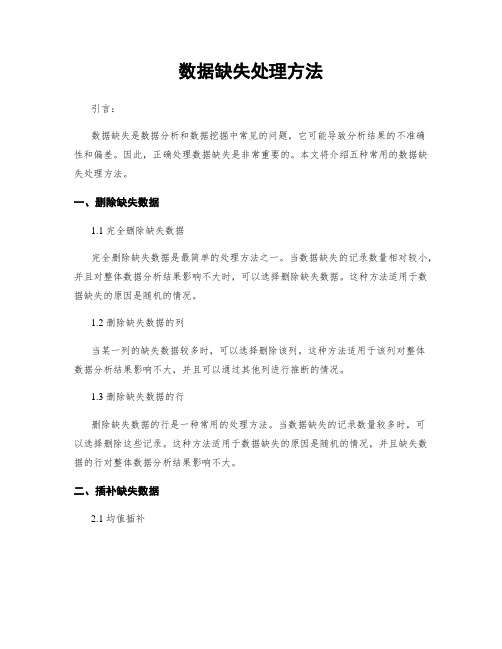
数据缺失处理方法引言:数据缺失是数据分析和数据挖掘中常见的问题,它可能导致分析结果的不准确性和偏差。
因此,正确处理数据缺失是非常重要的。
本文将介绍五种常用的数据缺失处理方法。
一、删除缺失数据1.1 完全删除缺失数据完全删除缺失数据是最简单的处理方法之一。
当数据缺失的记录数量相对较小,并且对整体数据分析结果影响不大时,可以选择删除缺失数据。
这种方法适用于数据缺失的原因是随机的情况。
1.2 删除缺失数据的列当某一列的缺失数据较多时,可以选择删除该列。
这种方法适用于该列对整体数据分析结果影响不大,并且可以通过其他列进行推断的情况。
1.3 删除缺失数据的行删除缺失数据的行是一种常用的处理方法。
当数据缺失的记录数量较多时,可以选择删除这些记录。
这种方法适用于数据缺失的原因是随机的情况,并且缺失数据的行对整体数据分析结果影响不大。
二、插补缺失数据2.1 均值插补均值插补是一种简单而常用的插补方法。
对于数值型数据,可以计算该列的均值,并将缺失值用均值进行替代。
这种方法适用于缺失数据的分布近似正态分布的情况。
2.2 中位数插补中位数插补是一种鲁棒性较好的插补方法。
对于数值型数据,可以计算该列的中位数,并将缺失值用中位数进行替代。
这种方法适用于缺失数据的分布存在较多异常值的情况。
2.3 回归插补回归插补是一种基于回归分析的插补方法。
对于数值型数据,可以通过其他相关变量建立回归模型,并利用该模型对缺失值进行预测和插补。
这种方法适用于缺失数据的分布存在一定规律的情况。
三、使用特殊值替代缺失数据3.1 使用0替代缺失数据当缺失数据表示某种情况下的缺失或者缺失数据的含义是0时,可以选择使用0来替代缺失数据。
这种方法适用于缺失数据的含义可以明确解释为0的情况。
3.2 使用平均值或中位数的标记值替代缺失数据当缺失数据的含义无法明确解释为0时,可以选择使用平均值或中位数的标记值(如-9999)来替代缺失数据。
这种方法适用于缺失数据的含义无法明确解释为0的情况。
处理缺失值的四种方法
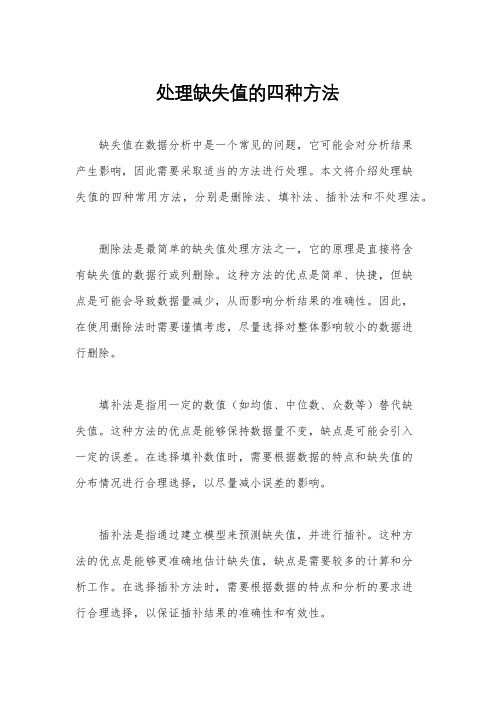
处理缺失值的四种方法
缺失值在数据分析中是一个常见的问题,它可能会对分析结果
产生影响,因此需要采取适当的方法进行处理。
本文将介绍处理缺
失值的四种常用方法,分别是删除法、填补法、插补法和不处理法。
删除法是最简单的缺失值处理方法之一,它的原理是直接将含
有缺失值的数据行或列删除。
这种方法的优点是简单、快捷,但缺
点是可能会导致数据量减少,从而影响分析结果的准确性。
因此,
在使用删除法时需要谨慎考虑,尽量选择对整体影响较小的数据进
行删除。
填补法是指用一定的数值(如均值、中位数、众数等)替代缺
失值。
这种方法的优点是能够保持数据量不变,缺点是可能会引入
一定的误差。
在选择填补数值时,需要根据数据的特点和缺失值的
分布情况进行合理选择,以尽量减小误差的影响。
插补法是指通过建立模型来预测缺失值,并进行插补。
这种方
法的优点是能够更准确地估计缺失值,缺点是需要较多的计算和分
析工作。
在选择插补方法时,需要根据数据的特点和分析的要求进
行合理选择,以保证插补结果的准确性和有效性。
不处理法是指直接在数据分析中忽略缺失值,将其视为一种特殊情况进行分析。
这种方法的优点是简单、快捷,缺点是可能会导致分析结果的偏差。
在选择不处理法时,需要根据数据的特点和分析的要求进行合理选择,以尽量减小偏差的影响。
综上所述,处理缺失值的四种方法各有优缺点,需要根据具体情况进行合理选择。
在实际应用中,可以根据数据的特点和分析的要求进行综合考虑,以选择最合适的方法进行处理,从而保证分析结果的准确性和有效性。
数据缺失处理方法

数据缺失处理方法概述:数据缺失是指在数据采集或者存储过程中,某些变量或者属性的值没有被记录或者保存下来。
数据缺失可能是由于设备故障、人为错误、数据传输错误或者其他原因导致的。
在数据分析和决策制定过程中,数据缺失可能会导致结果的不许确性和偏差。
因此,正确处理数据缺失是非常重要的。
本文将介绍几种常见的数据缺失处理方法,包括删除缺失值、插补缺失值和使用机器学习算法处理缺失值。
一、删除缺失值:删除缺失值是最简单的处理方法之一,适合于数据集中缺失值的比例较小的情况。
可以使用以下方法删除缺失值:1. 删除包含缺失值的行:如果某一行的某个变量的值缺失,可以选择删除该行。
这种方法适合于数据集中缺失值的比例较小的情况,删除缺失值后对整体数据影响较小。
2. 删除包含缺失值的列:如果某一列的大部份值都缺失,可以选择删除该列。
这种方法适合于某些变量的缺失值较多,且对整体数据影响较小的情况。
二、插补缺失值:插补缺失值是一种常见的数据缺失处理方法,通过预测或者估算缺失值来填充数据集。
常见的插补方法包括:1. 均值插补:对于数值型变量,可以使用整体数据集的均值来填充缺失值。
这种方法简单且易于实施,但可能会导致数据集的均值偏差。
2. 中位数插补:对于数值型变量,可以使用整体数据集的中位数来填充缺失值。
与均值插补相比,中位数插补对异常值更具鲁棒性。
3. 众数插补:对于分类变量,可以使用整体数据集的众数来填充缺失值。
众数插补适合于分类变量的缺失值处理。
4. 回归插补:对于数值型变量,可以使用其他相关变量建立回归模型,通过预测缺失值来填充。
这种方法可以更准确地估计缺失值,但需要注意回归模型的准确性和稳定性。
5. K近邻插补:对于数值型变量,可以使用K近邻算法来预测缺失值。
K近邻插补基于相似样本的特征进行预测,需要选择合适的K值和相似度度量方法。
三、使用机器学习算法处理缺失值:除了传统的插补方法,还可以使用机器学习算法处理数据缺失。
常见的机器学习算法包括决策树、随机森林、支持向量机等。
数据缺失处理方法

数据缺失处理方法数据缺失是指在数据集中存在一些变量或观察值未被收集或记录的情况。
数据缺失可能导致分析结果的不准确性和偏差。
因此,为了准确分析和综合处理数据,需要采取适当的方法处理数据缺失。
1.完全删除法:完全删除法是指直接删除存在缺失值的变量或观察值。
这种方法的优点是简单直接,不需要任何计算即可处理缺失数据。
然而,完全删除法也会导致缺失数据的丢失,可能会造成样本量减少和数据样本不再具有代表性的问题。
适用场景:当缺失值的比例较小且分布随机时,可以使用完全删除法。
2.单一插补法:单一插补法是指使用一个常数或者批定的值替代缺失值。
常见的单一插补法有均值插补、中位数插补和众数插补等。
这种方法的优点是简单易行,计算量小。
缺点是可能引入偏差,特别是当缺失值的模式和与其相关的变量之间存在关系时。
适用场景:当缺失值的比例较小,且缺失是随机的情况下,可以使用单一插补法。
3.多重插补法:多重插补法是指通过根据已有的变量信息,利用模型或者算法产生多个类似的数据集,并对每个数据集进行插补,最后结合多个插补数据集的分析结果得到最终结果。
常见的多重插补方法有多重插补法和概率型多重插补法(MICE)。
多重插补法的优点是可以更好地保留数据的分布特征和变量之间的相关性,同时提供了测量插补误差和不确定性的指标。
缺点是计算复杂度高,对计算机资源要求较高。
适用场景:当缺失值较多且缺失是非随机的情况下,可以使用多重插补法。
除了上述方法之外,还有其他的方法可以处理数据缺失,如基于模型的插补、模型集成插补、相似性插补等。
根据具体问题和数据集的特征,可以选择适当的缺失数据处理方法。
在使用任何缺失数据处理方法之前,需要先观察数据缺失的模式,了解缺失值的特征和背景信息,再选择合适的方法进行处理。
需要注意的是,数据缺失处理方法能够减少缺失数据对分析结果的影响,但并不能完全消除缺失数据带来的偏差。
因此,在使用处理后的数据进行分析时,需要考虑到可能存在的不确定性和偏差,并在结果解读和推断过程中进行充分的讨论和说明。
缺失值的检测与处理

缺失值的检测与处理在数据分析中,缺失值是一个常见的问题。
缺失值指的是数据集中某些变量的值缺失或未记录。
缺失值的存在会影响数据分析的准确性和可靠性,因此需要进行缺失值的检测与处理。
缺失值的检测缺失值的检测是指在数据集中找出缺失值的位置和数量。
常用的方法有:1. 直接查看数据集:通过查看数据集中的每个变量,找出其中的缺失值。
2. 描述性统计分析:通过计算每个变量的均值、中位数、标准差等统计量,发现其中的缺失值。
3. 可视化分析:通过绘制直方图、散点图等图表,发现其中的缺失值。
缺失值的处理缺失值的处理是指对缺失值进行填充或删除。
常用的方法有:1. 删除缺失值:将包含缺失值的行或列删除。
这种方法适用于缺失值较少的情况,但会导致数据集的样本量减少。
2. 填充缺失值:将缺失值用其他值进行填充。
常用的填充方法有:(1)均值填充:用变量的均值填充缺失值。
(2)中位数填充:用变量的中位数填充缺失值。
(3)众数填充:用变量的众数填充缺失值。
(4)回归填充:用其他变量的值进行回归分析,预测缺失值。
(5)插值填充:用插值方法进行填充,如线性插值、样条插值等。
需要注意的是,填充缺失值的方法应该根据数据集的特点和分析目的进行选择。
如果缺失值较多,填充方法可能会影响数据分析的准确性和可靠性,此时应该考虑删除缺失值。
总结缺失值的检测与处理是数据分析中的重要步骤。
缺失值的存在会影响数据分析的准确性和可靠性,因此需要进行缺失值的检测与处理。
常用的方法有直接查看数据集、描述性统计分析和可视化分析。
缺失值的处理方法包括删除缺失值和填充缺失值,填充方法应该根据数据集的特点和分析目的进行选择。
- 1、下载文档前请自行甄别文档内容的完整性,平台不提供额外的编辑、内容补充、找答案等附加服务。
- 2、"仅部分预览"的文档,不可在线预览部分如存在完整性等问题,可反馈申请退款(可完整预览的文档不适用该条件!)。
- 3、如文档侵犯您的权益,请联系客服反馈,我们会尽快为您处理(人工客服工作时间:9:00-18:30)。
缺失值1. is.na 确实值位置判断注意: 缺失值被认为是不可比较的,即便是与缺失值自身的比较。
这意味着无法使用比较运算符来检测缺失值是否存在。
例如,逻辑测试myvar == NA的结果永远不会为TRUE。
作为替代,你只能使用处理缺失值的函数(如本节中所述的那些)来识别出R数据对象中的缺失值。
2. na.omit() 删除不完整观测manyNAslibrary(DMwR)manyNAs(data, nORp = 0.2)ArgumentsdataA data frame with the data set.nORpA number controlling when a row is considered to have too many NA values (defaults to0.2, i.e. 20% of the columns). If no rows satisfy the constraint indicated by the user, awarning is generated.按照比例判断缺失.3. knnImputation K 近邻填补library(DMwR)knnImputation(data, k = 10, scale = T, meth = "weighAvg", distData = NULL)∙1 ∙ 2ArgumentsArgumentsdataA data frame with the data set kThe number of nearest neighbours to use (defaults to 10) scale Boolean setting if the data should be scale before finding the nearest neighbours (defaults toT)methString indicating the method used to calculate the value to fill in each NA. Available values are ‘median’ or ‘weighAvg’ (the default).distData Optionally you may sepecify here a data frame containing the data set that should be used to find the neighbours. This is usefull when filling in NA values on a test set, where youshould use only information from the training set. This defaults to NULL, which means thatthe neighbours will be searched in dataDetailsThis function uses the k-nearest neighbours to fill in the unknown (NA) values in a data set. For each case with any NA value it will search for its k most similar cases and use the values of these cases to fill in the unknowns.If meth=’median’ the function will use either the median (in case of numeric variables) or the most frequent value (in case of factors), of the neighbours to fill in the NAs. Ifmeth=’weighAvg’ the function will use a weighted average of the values o f the neighbours. The weights are given by exp(-dist(k,x) where dist(k,x) is the euclidean distance between the case with NAs (x) and the neighbour k例子:#首先读入程序包并对数据进行清理library(DMwR)data(algae)algae <- algae[-manyNAs(algae), ]clean.algae <- knnImputation(algae[,1:12],k=10)∙ 1∙ 2∙ 3∙ 4∙ 5> head(clean.algae)season size speed mxPH mnO2 Cl NO3 NH4 oPO4 PO4 Chla a11 winter small medium 8.00 9.8 60.800 6.238 578.000 105.000 170.000 50.0 0.02 spring small medium 8.35 8.0 57.750 1.288 370.000 428.750 558.750 1.3 1.43 autumn small medium 8.10 11.4 40.020 5.330 346.667 125.667 187.057 15.63.34 spring small medium 8.07 4.8 77.364 2.302 98.182 61.182 138.700 1.4 3.15 autumn small medium 8.06 9.0 55.350 10.416 233.700 58.222 97.580 10.5 9.26 winter small high 8.25 13.1 65.750 9.248 430.000 18.250 56.667 28.4 15.1∙ 1∙ 2∙ 3∙ 4∙ 5∙ 6∙7∙84. centralImputation()中心插值用非缺失样本的中位数(median)对缺失数据进行插值data(algae)cleanAlgae <- centralImputation(algae)summary(cleanAlgae)∙ 1∙ 2∙ 35. complete.cases() 寻找完整数据集x <- airquality[, -1] # x is a regression design matrixy <- airquality[, 1] # y is the corresponding response#验证是否complete.cases结果与is.na一样stopifnot(complete.cases(y) != is.na(y))#x,y共同的非缺失行的bool结果ok <- complete.cases(x, y)#共有几个缺失样本sum(!ok) # how many are not "ok" ?#得到非缺失样本x <- x[ok,]y <- y[ok]∙ 1∙ 2∙ 3∙ 4∙ 5∙ 6∙7∙8∙9∙10∙116. na.fail()是否有遗漏值DF <- data.frame(x = c(1, 2, 3), y = c(0, 10, NA)) na.fail(DF)Error in na.fail.default(DF) : 对象里有遺漏值∙ 1∙ 2∙ 3∙ 42016四月27R语言︱缺失值处理之多重插补——mice包(253)(0)笔者寄语:缺失值是数据清洗过程中非常重要的问题(其他方法可见:R语言︱异常值检验、离群点分析、异常值处理),笔者在进行mice包的多重插补过程中遇到相当多的问题。
大致的步骤简介如下:缺失数据集——MCMC估计插补成几个数据集——每个数据集进行插补建模(glm、lm模型)——将这些模型整合到一起(pool)——评价插补模型优劣(模型系数的t统计量)——输出完整数据集(compute)步骤详细介绍:函数mice()首先从一个包含缺失数据的数据框开始,然后返回一个包含多个(默认为5个)完整数据集的对象。
每个完整数据集都是通过对原始数据框中的缺失数据进行插补而生成的。
由于插补有随机的成分,因此每个完整数据集都略有不同。
然后, with()函数可依次对每个完整数据集应用统计模型(如线性模型或广义线性模型),最后, pool()函数将这些单独的分析结果整合为一组结果。
最终模型的标准误和p 值都将准确地反映出由于缺失值和多重插补而产生的不确定性。
1.#多重插补法处理缺失,结果转存2.library(lattice) #调入函数包3.library(MASS)4.library(nnet)5.library(mice) #前三个包是mice的基础6.imp=mice(inputfile,m=4) #4重插补,即生成4个无缺失数据集7.fit=with(imp,lm(sales~date,data=inputfile))#选择插补模型8.pooled=pool(fit)9.summary(pooled)10.result4=complete(imp,action=3)#选择第三个插补数据集作为结果结果解读:(1)imp对象中,包含了:每个变量缺失值个数信息、每个变量插补方式(PMM,预测均值法常见)、插补的变量有哪些、预测变量矩阵(在矩阵中,行代表插补变量,列代表为插补提供信息的变量,1和0分别表示使用和未使用);同时利用这个代码imp$imp$sales 可以找到,每个插补数据集缺失值位置的数据补齐具体数值是啥。
[plain]view plain copy1.> imp$imp$sales2. 1 2 3 43.9 3614.7 3393.1 4060.3 3393.14.15 2332.1 3614.7 3295.5 3614.7(2)with对象。
插补模型可以多样化,比如lm,glm都是可以直接应用进去,详情可见《R语言实战》第十五章;(3)pool对象。
summary之后,会出现lm模型系数,可以如果出现系数不显著,那么则需要考虑换插补模型;(4)complete对象。
m个完整插补数据集,同时可以利用此函数输出。
————————————————————————————————————————————————————1、缺失值模式——可视化(md.pattern())mice包提供了一个很好的函数md.pattern(),用它可以对缺失数据的模式有个更好的理解。
